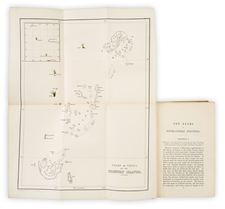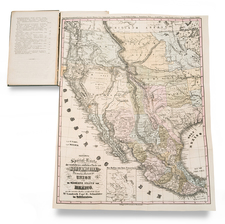The Apotheosis of Fine Binding.
An Exceptionally Fine Sangorski & Sutcliffe "Peacock" Binding. With Contemporary Documentation of the Binding and Binder.
"...the whole design symbolizing Life and Death." - Sangorski & Sutcliffe, 1921
A spectacularly-bound 1868 second edition of The Rubaiyat of Omar Khayyam, which was first translated by Edward FitzGerald in 1859. The book is a collection of quatrains expressing the poet's reflections on life and the universe. Central to the poem is the theme of carpe diem, or "seize the day," urging readers to embrace the pleasures of the moment in the face of the inevitable passage of time and the impermanence of life. Khayyam philosophically contemplates the mysteries of existence, fate, and the cosmos, often expressing skepticism about the afterlife and disillusionment with the divine. The poet's lyrical embrace of life's joys—wine, nature, love—is tinged with melancholy about their fleeting nature, making the work a poignant meditation on the human condition. The imagery is rich and evocative, blending sensual pleasure with profound existential inquiry, all woven together by the inevitability of mortality.
The present example is accompanied by two letters on three sheets, both roughly contemporaneous with the binding of the book. The latter, from the bookseller Charles J. Sawyer, Ltd., aptly summarizes the importance of the Peacock Bindings to book collectors:
Owing to the complexity of the work and the great amount of time devoted to it, only a few of these "Peacock" bindings were executed and ever since the first one appeared [in 1906], competition among collectors to own one has been keen both in Britain and the United States.
A post-script states:
Mr. Bray (the Proprietor of S. & S.) has told us that this was tooled by Bill Finch in 1921 and would have taken him approximately two to three months. The forwarding was by Mr. Burns who, according to Mr. Bray, was the best forwarder in the business. In Mr. Bray's opinion the back-ground stopping was very good indeed.
Peacock Bindings
The Peacock Bindings of Sangorski & Sutcliffe have become the stuff of bibliophilic legend due not only to their extreme complexity, craftsmanship, and aesthetic appeal but also to the tragic loss of one of the most spectacular examples of its kind ("The Great Omar") upon the sinking of the Titanic in 1912. See Elkind's "Jewelled Bindings", in the Autumn 1975 issue of The Book Collector for a detailed treatment of this episode and the Peacock Bindings more generally.
A comparison of this binding with other Peacock Bindings, including The Great Omar, uncovers continuities and repeated motifs, as well as tiers of craftsmanship and complexity. While the appeal of any one of these bindings is inherently subjective, the present example is among the finest and most elaborate that has appeared on the market in several decades.
Provenance
Charles J. Sawyer, the London dealer - alongside Southern and Maggs, a major conduit for jeweled Sangorski & Sutcliffe bindings.
C.F.J. Beausire, his bookplate.
Christie's New York, 18 December 2003, lot 69; as "Property of a Texas Collector".
Heritage Book Shop, Inc.
Private collection, Beverly Hills, California.
Pagination: xviii, 30 pages.












![(Fremont Court-Martial) Message of the President of the United States, Communicating the Proceedings of the Court Martial in the Trial of Lieutenant Colonel Frémont. April 7, 1848 [caption title]](https://storage.googleapis.com/raremaps/img/small/99039.jpg)

![Directions for Sailing to and from the East Indies, China, New Holland, Cape of Good Hope, and the Interjacent Ports; Compiled Chiefly from Original Journals at the East India House, and from Journals and Observations made during Twenty-One Years Experience Navigation in Those Seas... Part First. [With:] ...Part Second.](https://storage.googleapis.com/raremaps/img/small/102206.jpg)

